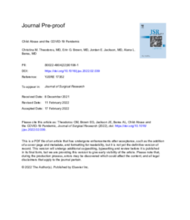Background
The COVID-19 pandemic had widespread effects, including enhanced psychosocial stressors and stay-at-home orders which may be associated with higher rates of child abuse. The researchers aimed to evaluate rates of child abuse, neglect, and inadequate supervision during the COVID-19 pandemic.
Methods
Patients ≤5 years old admitted to a level one pediatric trauma center between 3/19/20-9/19/20 (COVID-era) were compared to a pre-COVID cohort (3/19/19-9/19/19). The primary outcome was the rate of child abuse, neglect, or inadequate supervision, determined by Child Protection Team and Social Work consultations. Secondary outcomes included injury severity score (ISS), mortality, and discharge disposition.
Results
Of 163 total COVID-era pediatric trauma patients, 22 (13.5%) sustained child abuse/neglect, compared to 17 of 206 (8.3%) pre-COVID era patients (p=0.13). The ISS was similar between cohorts (median 9 pre-COVID vs. 5 COVID-era, p=0.23). There was one mortality in the pre-COVID era and none during COVID (p=0.45). The rate of discharge with someone other than the primary caregiver at time of injury was significantly higher pre-COVID (94.1% vs. 59.1%, p = 0.02). Additionally, foster family placement rate was twice as high pre-COVID (50.0% vs. 22.7%, p=0.10).
Conclusion
The rate of abuse/neglect among young pediatric trauma patients during COVID did not differ compared to pre-pandemic, but discharge to a new caregiver was significantly lower. While likely multifactorial, this data suggests that resources during COVID may have been limited and the clinical significance of this is concerning. Larger studies are warranted to further evaluate COVID-19’s effect on this vulnerable population.

